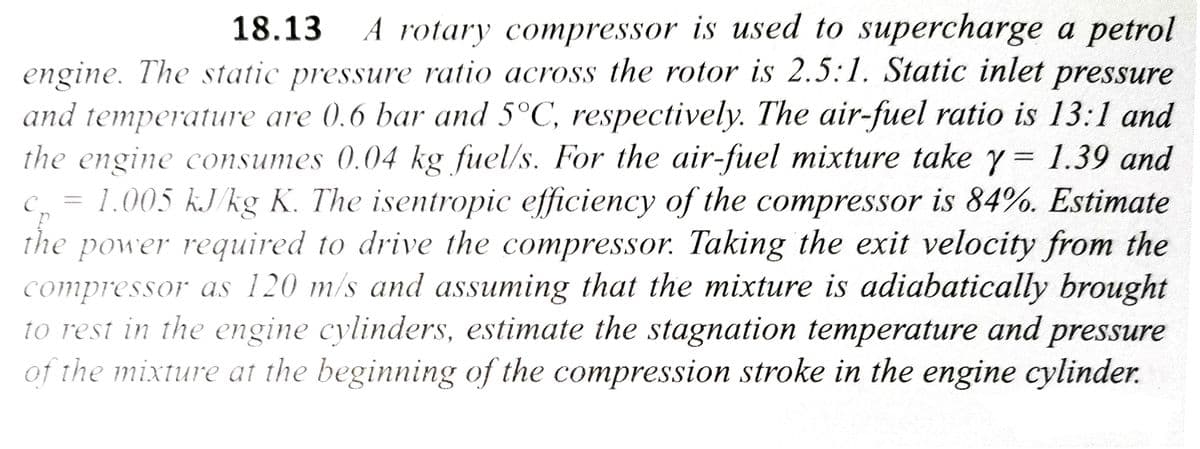18.13 A rotary compressor is used to supercharge a petrol engine. The static pressure ratio across the rotor is 2.5:1. Static inlet pressure and temperature are 0.6 bar and 5°C, respectively. The air-fuel ratio is 13:1 and the engine consumes 0.04 kg fuel/s. For the air-fuel mixture take y = 1.39 and 1.005 kJ/kg K. The isentropic efficiency of the compressor is 84%. Estimate power required to drive the compressor. Taking the exit velocity from the compressor as 120 m/s and assuming that the mixture is adiabatically brought to rest in the engine cylinders, estimate the stagnation temperature and pressure of the mixture at the beginning of the compression stroke in the engine cylinder. с = the
18.13 A rotary compressor is used to supercharge a petrol engine. The static pressure ratio across the rotor is 2.5:1. Static inlet pressure and temperature are 0.6 bar and 5°C, respectively. The air-fuel ratio is 13:1 and the engine consumes 0.04 kg fuel/s. For the air-fuel mixture take y = 1.39 and 1.005 kJ/kg K. The isentropic efficiency of the compressor is 84%. Estimate power required to drive the compressor. Taking the exit velocity from the compressor as 120 m/s and assuming that the mixture is adiabatically brought to rest in the engine cylinders, estimate the stagnation temperature and pressure of the mixture at the beginning of the compression stroke in the engine cylinder. с = the
Elements Of Electromagnetics
7th Edition
ISBN:9780190698614
Author:Sadiku, Matthew N. O.
Publisher:Sadiku, Matthew N. O.
ChapterMA: Math Assessment
Section: Chapter Questions
Problem 1.1MA
Related questions
Question

Transcribed Image Text:18.13 A rotary compressor is used to supercharge a petrol
engine. The static pressure ratio across the rotor is 2.5:1. Static inlet pressure
and temperature are 0.6 bar and 5°C, respectively. The air-fuel ratio is 13:1 and
the engine consumes 0.04 kg fuel/s. For the air-fuel mixture take y = 1.39 and
1.005 kJ/kg K. The isentropic efficiency of the compressor is 84%. Estimate
the power required to drive the compressor. Taking the exit velocity from the
compressor as 120 m/s and assuming that the mixture is adiabatically brought
to rest in the engine cylinders, estimate the stagnation temperature and pressure
of the mixture at the beginning of the compression stroke in the engine cylinder.
с
Expert Solution
This question has been solved!
Explore an expertly crafted, step-by-step solution for a thorough understanding of key concepts.
Step by step
Solved in 2 steps

Knowledge Booster
Learn more about
Need a deep-dive on the concept behind this application? Look no further. Learn more about this topic, mechanical-engineering and related others by exploring similar questions and additional content below.Recommended textbooks for you

Elements Of Electromagnetics
Mechanical Engineering
ISBN:
9780190698614
Author:
Sadiku, Matthew N. O.
Publisher:
Oxford University Press

Mechanics of Materials (10th Edition)
Mechanical Engineering
ISBN:
9780134319650
Author:
Russell C. Hibbeler
Publisher:
PEARSON

Thermodynamics: An Engineering Approach
Mechanical Engineering
ISBN:
9781259822674
Author:
Yunus A. Cengel Dr., Michael A. Boles
Publisher:
McGraw-Hill Education

Elements Of Electromagnetics
Mechanical Engineering
ISBN:
9780190698614
Author:
Sadiku, Matthew N. O.
Publisher:
Oxford University Press

Mechanics of Materials (10th Edition)
Mechanical Engineering
ISBN:
9780134319650
Author:
Russell C. Hibbeler
Publisher:
PEARSON

Thermodynamics: An Engineering Approach
Mechanical Engineering
ISBN:
9781259822674
Author:
Yunus A. Cengel Dr., Michael A. Boles
Publisher:
McGraw-Hill Education

Control Systems Engineering
Mechanical Engineering
ISBN:
9781118170519
Author:
Norman S. Nise
Publisher:
WILEY

Mechanics of Materials (MindTap Course List)
Mechanical Engineering
ISBN:
9781337093347
Author:
Barry J. Goodno, James M. Gere
Publisher:
Cengage Learning

Engineering Mechanics: Statics
Mechanical Engineering
ISBN:
9781118807330
Author:
James L. Meriam, L. G. Kraige, J. N. Bolton
Publisher:
WILEY